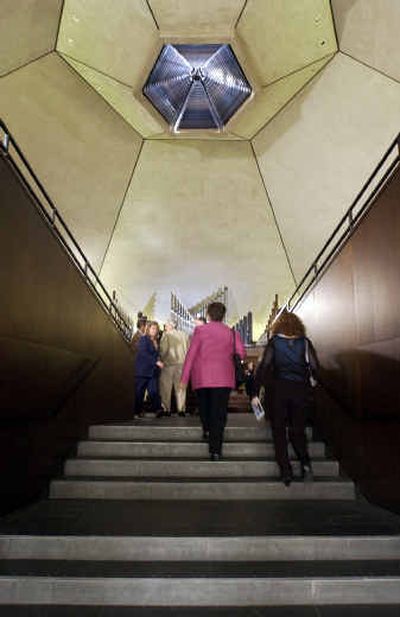Design, devotion

Why is it that the arches and open spaces of a cathedral inspire faith, yet so does the comfort and familiarity of a small country chapel?
The connection between design and devotion is under study by a group of clerics, neuroscientists and architects who are trying to understand how the mind reacts to the sensations of entering a house of worship.
The result, they hope, will be better designs that enhance the meeting of the sacred and earthly.
“This whole quest is more than learning that things do happen — but why do they happen?” said Norman Koonce, chief executive of the American Institute of Architects and father of the partnership.
Koonce became interested in neuroscience more than a decade ago after he met Jonas Salk, who developed the polio vaccine. The doctor told Koonce that while stymied on a breakthrough, he made a retreat to Assisi, Italy. The great buildings of the monastery town inspired Salk to think more deeply and design the research that produced the breakthrough.
Learning about such experiences was the focus recently as about 30 representatives from religion, science and architecture gathered for two days in an architectural mecca set amid the cornfields of southern Indiana.
The AIA ranks Columbus, Ind., a city of 39,000, right up there with New York, Chicago and Washington for its design and innovation. Four winners of the field’s prestigious Pritzker Prize worked here, including I.M. Pei, who designed the library.
The local faith community shares an appreciation for design. A Lutheran congregation hired Gunnar Birkerts, who created a circular sanctuary that highlights the unity of the congregation. A Baptist church on the outskirts of town brought in Harry Weese, who left a “pierced wall” of brick behind the altar to remind worshippers of the Crucifixion.
At the meeting, attendees discussed symbolism, sight lines, acoustics and what defines a “sacred” space.
They left planning experiments that might advance their dialogue, which organizers hope to resume next year. The Rev. Robert Schuller, who spoke to the group, has invited it to meet in 2005 at the Philip Johnson-designed Crystal Cathedral in Garden Grove, Calif.
The Academy of Neuroscience for Architecture, an AIA affiliate based in San Diego, also is building on the work of psychiatrist Dr. Andrew Newberg of the University of Pennsylvania. His experiments with Franciscan nuns and Buddhist monks deep in meditation showed him that they could attain states in which they felt united with a greater spirit or force.
“In deeply religious states, they find a sense of oneness with the world,” said the Rev. Patrick Russell of Lafayette Hill, Pa., a neuroscientist turned Lutheran minister.
The roots of that experience might lie in how the brain works.
Many neuroscientists believe parts of the brain are wired by billions of nerve cells that work within fractions of a second to form sensations, memories and feelings.
The brain does this with an estimated 60,000 miles of neural wiring — a length greater than the total distance of the U.S. interstate highway system. It’s as complicated as carrying on 10,000 conversations at once, Russell said.
When the setting is a synagogue or a cathedral, the way it looks or sounds can enhance or diminish the worship experience.
Columbus architect Nolan Bingham told the meeting how tears had welled in the eyes of a Jewish woman as she walked into a house of prayer outside her own tradition, the city’s landmark North Christian Church.
Built by Eero Saarinen, better known for the Gateway Arch in St. Louis, it conveys “sacred space” as few other places can, with a roof that appears to float on air and a spire that soars 192 feet.
When Bingham asked why she was crying, the woman could not explain it, he said.
“That’s what I want to know,” Bingham said. “There is not an easy answer for that. How do you find that thing?”